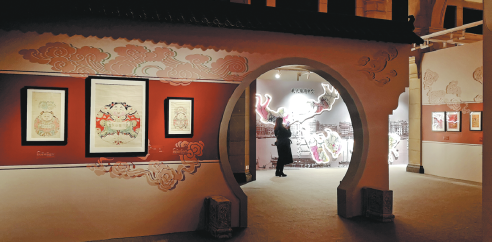
From the People's Daily App.
This is Story in the Story.
Xi Wang, a 29-year-old craftsman, hangs up a self-designed New Year picture depicting two cheerful kids and an adorable mouse on the wall of his room to celebrate the Chinese Year of the Rat.
As the youngest inheritor of Yangliuqing Woodblock Printing in north China's Tianjin Municipality, Xi was busy making mouse-themed artworks at the beginning of this year.
New Year pictures, or nianhua in Chinese, are a type of traditional painting that people, particularly in the countryside, hang on their doors, windows or walls to ward off evil spirits and express good wishes for the Chinese Lunar New Year.
Yangliuqing Woodblock Printing is one of the most prestigious forms of New Year decorations in China, which flourished in Tianjin and the surrounding areas during a period between the late Ming Dynasty (1368-1644) and the early Qing Dynasty (1644-1911).
Today’s Story in the Story looks at how woodblock printing has become a unique genre of folk art in China

The ongoing exhibition at the Shanghai History Museum showcases 87 works of Chinese New Year prints created during the period spanning the Qing Dynasty (1644-1911) to the early 20th century. (Photo: China Daily)
As a local raised in Tianjin, Xi has been a fan of this art form since his childhood.
"Back then, every family would put up woodblock paintings on the walls. Their beautiful colors and vivid figures impressed me a lot when I was a kid," Xi recalled.
Only when he grew up did he gradually come to know the splendid culture and history behind Yangliuqing Woodblock Printing, a national intangible cultural heritage featuring abundant themes inspired by literature, folk legends and myths.
He has devoted himself to engraving wood since he became an apprentice of woodblock printing in 2014.
Engraving wood is never an easy job. Xi pastes the outline of the design onto a piece of pear wood and carves the whole ink-line image out of the wood board, which may take one or even two months for him to complete.
The lines of kids' arms and legs and the details on their faces including eyes are the most challenging parts to carve, as these thin lines should be smooth and graceful enough to show the figures' vivid and artistic expressions.
Good tools are always essential to create an excellent woodblock. On Xi's workbench are placed a dozen carving chisels and woodcut knives, all of which he made by hand. Prime wood is selected to make the hilt, while high-strength steel is the best choice to be ground into various types of carving knives.
"As I get more and more familiar with these tools, they seem to become part of my fingers," Xi said.
Lunar New Year prints have become a unique genre of folk art that is deeply rooted in the lives and beliefs of ordinary Chinese, says Hu Jiang, director of the Shanghai History Museum.

A Qing Dynasty Lunar New Year print features a mother with her kids, a production of Taohuawu in Suzhou, Jiangsu province. (Photo: China Daily)
"These pictures reflect people's wish for a good life, their life philosophy and beliefs. It also shows the wit, wisdom and entertainment of ordinary people," he says.
Lunar New Year prints make up an important section in the Shanghai History Museum's collection as they reflect the local heritage and culture of the city, says Shao Wenjing, curator of the exhibition and a researcher at the museum.
It was Wei Juxian (1899-1989), a historian and archaeologist from Shanghai who donated the prints to the Chongqing government after the People's Liberation Army took over the city from the Japanese in 1949. He donated a total of 22,600 pieces from his collection to show his support and loyalty to the new government.
In the 1950s, the Chongqing Museum was built, and Wei's donation was merged with the new museum's collection. The same happened in 2000 when the Chongqing Museum was subsumed by the new Chongqing China Three Gorges Museum.
According to Zhang Rongxiang, head of the Three Gorges Museum, Wei's donations have been an important asset for the museum.
"Researchers have made many discoveries and publications about these works, and more importantly we have shared the artworks with the public in Chongqing and other parts of China," Zhang says, adding that the Lunar New Year prints have been on exhibition frequently, especially during Spring Festival.
(Produced by Nancy Yan Xu, Brian Lowe, Lance Crayon and Paris Yelu Xu. Music by: bensound.com. Text from Xinhua, China Daily)


